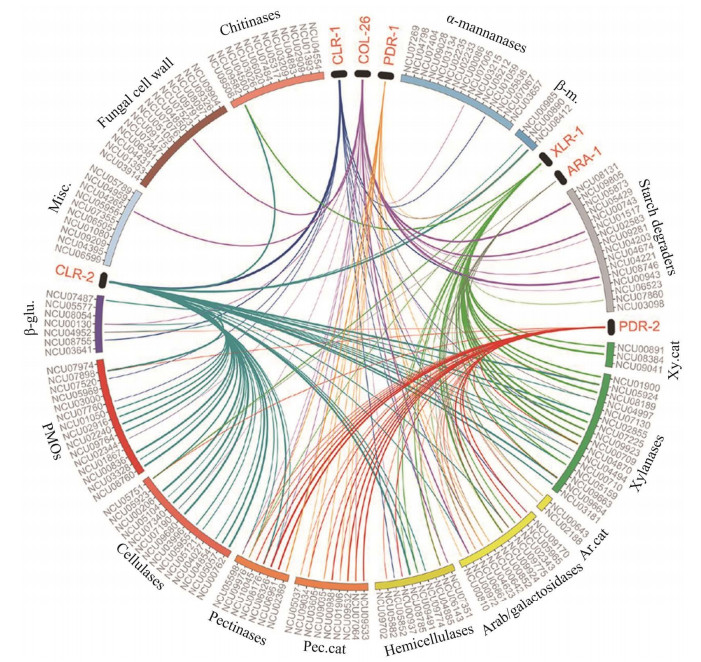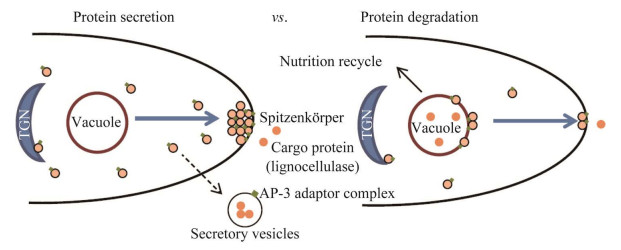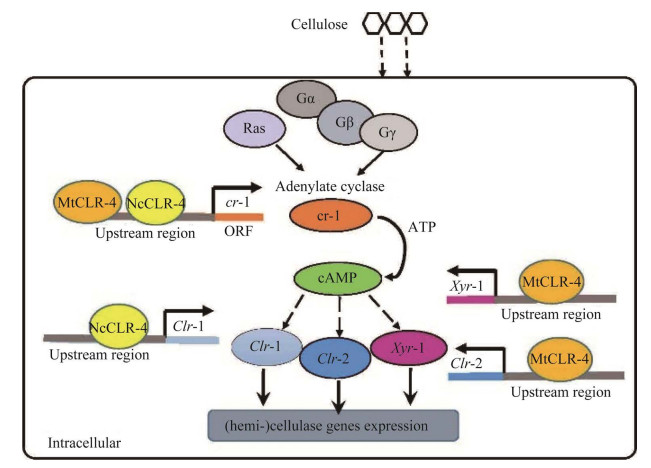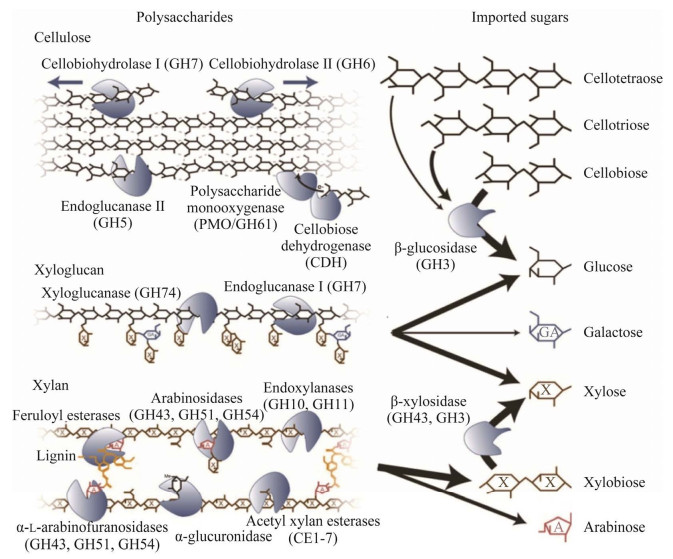| [1] | |
|
| [2] | |
|
| [3] |
Huberman LB, Liu J, Qin LN, et al. Regulation of the lignocellulolytic response in filamentous fungi. Fungal Biol Rev, 2016, 30(3): 101-111. DOI:10.1016/j.fbr.2016.06.001
|
|
| [4] |
Meng J, Makela MR, De Vries RP. Molecular engineering to improve lignocellulosic biomass based applications using filamentous fungi. Adv Appl Microbiol, 2021, 114: 73-109.
|
|
| [5] |
Znameroski E A, Glass N L. Using a model filamentous fungus to unravel mechanisms of lignocellulose deconstruction. Biotechnol Biofuels, 2013, 6(1): 6. DOI:10.1186/1754-6834-6-6
|
|
| [6] |
Reese ET, Siu R GH, Levinson HS. The biological degration of the soluble cellulose derivatives and its relationship to the mechanism of cellulose hydrolysis. J Bacteriol, 1950, 59: 485-497. DOI:10.1128/jb.59.4.485-497.1950
|
|
| [7] |
Wood TM. Properties of cellulolytic enzyme systems. Biochem Soc Trans, 1985, 13(2): 407-410. DOI:10.1042/bst0130407
|
|
| [8] |
Himmel ME, Ding SY, Johnson DK, et al. Biomass recalcitrance: engineering plants and enzymes for biofuels production. Science, 2007, 315(5813): 804-807. DOI:10.1126/science.1137016
|
|
| [9] |
Harris PV, Welner D, Mcfarland KC, et al. Stimulation of lignocellulosic biomass hydrolysis by proteins of glycoside hydrolase family 61: structure and function of a large, enigmatic family. Biochem, 2010, 49(15): 3305-3316. DOI:10.1021/bi100009p
|
|
| [10] |
Morgenstern I, Powlowski J, Tsang A. Fungal cellulose degradation by oxidative enzymes: from dysfunctional GH61 family to powerful lytic polysaccharide monooxygenase family. Brief in Funct Genomics, 2014, 13(6): 471-481. DOI:10.1093/bfgp/elu032
|
|
| [11] |
Coradetti ST, Craig JP, Xiong Y, et al. Conserved and essential transcription factors for cellulase gene expression in ascomycete fungi. PNAS, 2012, 109(19): 7397-7402. DOI:10.1073/pnas.1200785109
|
|
| [12] |
Coradetti ST, Xiong Y, Glass NL. Analysis of a conserved cellulase transcriptional regulator reveals inducer-independent production of cellulolytic enzymes in Neurospora crassa. Microbiologyopen, 2013, 2(4): 595-609. DOI:10.1002/mbo3.94
|
|
| [13] |
Wu VW, Thieme N, Huberman LB, et al. The regulatory and transcriptional landscape associated with carbon utilization in a filamentous fungus. PNAS, 2020, 117(11): 6003-6013. DOI:10.1073/pnas.1915611117
|
|
| [14] |
Wang M, Dong Y, Zhao Q, et al. Identification of the role of a MAP kinase Tmk2 in Hypocrea jecorina (Trichoderma reesei). Sci Rep, 2014, 4: 6732.
|
|
| [15] |
Wang MY, Zhao QS, Yang JH, et al. A mitogen-activated protein kinase Tmk3 participates in high osmolarity resistance, cell wall integrity maintenance and cellulase production regulation in Trichoderma reesei. PLos One, 2013, 8(8): e72189. DOI:10.1371/journal.pone.0072189
|
|
| [16] |
Schuster A, Tisch D, Seidl-Seiboth V, et al. Roles of protein kinase A and adenylate cyclase in light- modulated cellulase regulation in Trichoderma reesei. Appl Environ Microbiol, 2012, 78(7): 2168-2178. DOI:10.1128/AEM.06959-11
|
|
| [17] |
Lv X, Zhang W, Chen G, et al. Trichoderma reesei Sch9 and Yak1 regulate vegetative growth, conidiation, and stress response and induced cellulase production. J Microbiol, 2015, 53(4): 236-242. DOI:10.1007/s12275-015-4639-x
|
|
| [18] |
Tian CG, Beeson WT, Iavarone AT, et al. Systems analysis of plant cell wall degradation by the model filamentous fungus Neurospora crassa. PNAS, 2009, 106(52): 22157-22162. DOI:10.1073/pnas.0906810106
|
|
| [19] |
Wang B, Cai PG, Sun WL, et al. A transcriptomic analysis of Neurospora crassa using five major crop residues and the novel role of the sporulation regulator rca-1 in lignocellulase production. Biotechnol Biofuels, 2015, 8: 21. DOI:10.1186/s13068-015-0208-0
|
|
| [20] |
Fan FY, Ma GL, Li JG, et al. Genome-wide analysis of the endoplasmic reticulum stress response during lignocellulase production in Neurospora crassa. Biotechnol Biofuels, 2015, 8: 66. DOI:10.1186/s13068-015-0248-5
|
|
| [21] |
Pei X, Fan F, Lin L, et al. Involvement of the adaptor protein 3 complex in lignocellulase secretion in Neurospora crassa revealed by comparative genomic screening. Biotechnol Biofuels, 2015, 8: 124. DOI:10.1186/s13068-015-0302-3
|
|
| [22] |
李慧燕, 林良才, 肖冬光, 等. 粗糙脉孢菌C_2H_2转录因子家族基因敲除突变体产纤维素酶筛选分析. 菌物学报, 2016, 35(2): 161-169. Li HY, Lin LC, Xiao DG, et al. Genome-wide screening of C 2H 2 family transcription factor gene knock-out mutants for high expression of cellulose in Neurospora crassa. Mycosystema, 2016, 35(2): 161-169 (in Chinese). DOI:10.13346/j.mycosystema.140235
|
|
| [23] |
王珊珊, 林良才, 贾士儒, 等. 粗糙脉孢菌丝氨酸/苏氨酸激酶家族基因敲除库纤维素酶表达分泌研究. 微生物学通报, 2017, 44(6): 1303-1311. Wang SS, Lin LC, Jia SR, et al. Cellulase expression analysis of serine/threonine kinase gene deletion mutants of Neurospora crassa. Microbiol China, 2017, 44(6): 1303-1311 (in Chinese). DOI:10.13344/j.microbiol.china.160698
|
|
| [24] |
田朝光, 林良才, 李金根. 一种强化丝状真菌蛋白质生产的方法: CN201510225828.1, China. 2020-06-26.
|
|
| [25] |
田朝光, 马国力, 樊飞宇. 一种改善丝状真菌蛋白分泌能力的方法: CN201510225762.6, China. 2020-06-26.
|
|
| [26] |
Liu Q, Li J, Gao R, et al. CLR-4, a novel conserved transcription factor for cellulase gene expression in ascomycete fungi. Mol Microbiol, 2019, 111(2): 373-394. DOI:10.1111/mmi.14160
|
|
| [27] |
Lin L, Wang S, Li X, et al. STK-12 acts as a transcriptional brake to control the expression of cellulase-encoding genes in Neurospora crassa. PLoS Genet, 2019, 15(11): e1008510. DOI:10.1371/journal.pgen.1008510
|
|
| [28] |
Lin L C, Chen Y, Li J G, et al. Disruption of non-anchored cell wall protein NCW-1 promotes cellulase production by increasing cellobiose uptake in Neurospora crassa. Biotechnol Lett, 2017, 39(4): 545-551. DOI:10.1007/s10529-016-2274-1
|
|
| [29] |
Lin L, Sun Z, Li J, et al. Disruption of gul-1 decreased the culture viscosity and improved protein secretion in the filamentous fungus Neurospora crassa. Microb Cell Fact, 2018, 17(1): 96. DOI:10.1186/s12934-018-0944-5
|
|
| [30] |
Zhao Q, Liu Q, Wang Q, et al. Disruption of the Trichoderma reesei gul1 gene stimulates hyphal branching and reduces broth viscosity in cellulase production. J Ind Microbiol Biotechnol, 2021, 48(1-2).
|
|
| [31] |
Garcia Sanchez R, Karhumaa K, Fonseca C, et al. Improved xylose and arabinose utilization by an industrial recombinant Saccharomyces cerevisiae strain using evolutionary engineering. Biotechnol Biofuels, 2010, 3: 13. DOI:10.1186/1754-6834-3-13
|
|
| [32] |
Kahar P, Taku K, Tanaka S. Enhancement of xylose uptake in 2-deoxyglucose tolerant mutant of Saccharomyces cerevisiae. J Biosci Bioeng, 2011, 111(5): 557-563. DOI:10.1016/j.jbiosc.2010.12.020
|
|
| [33] |
Leandro MJ, Goncalves P, Spencer-Martins I. Two glucose/xylose transporter genes from the yeast Candida intermedia: first molecular characterization of a yeast xylose-H + symporter. Biochem J, 2006, 395(3): 543-549. DOI:10.1042/BJ20051465
|
|
| [34] |
Young EM, Comer AD, Huang H, et al. A molecular transporter engineering approach to improving xylose catabolism in Saccharomyces cerevisiae. Metab Eng, 2012, 14(4): 401-411. DOI:10.1016/j.ymben.2012.03.004
|
|
| [35] |
Wang C, Bao X, Li Y, et al. Cloning and characterization of heterologous transporters in Saccharomyces cerevisiae and identification of important amino acids for xylose utilization. Metab Eng, 2015, 30: 79-88. DOI:10.1016/j.ymben.2015.04.007
|
|
| [36] |
Young EM, Tong A, Bui H, et al. Rewiring yeast sugar transporter preference through modifying a conserved protein motif. PNAS, 2014, 111(1): 131-136. DOI:10.1073/pnas.1311970111
|
|
| [37] |
Farwick A, Bruder S, Schadeweg V, et al. Engineering of yeast hexose transporters to transport D-xylose without inhibition by D-glucose. PNAS, 2014, 111(14): 5159-5164. DOI:10.1073/pnas.1323464111
|
|
| [38] |
Ha SJ, Galazka JM, Kim SR, et al. Engineered Saccharomyces cerevisiae capable of simultaneous cellobiose and xylose fermentation. PNAS, 2011, 108(2): 504-509. DOI:10.1073/pnas.1010456108
|
|
| [39] |
Galazka JM, Tian C, Beeson WT, et al. Cellodextrin transport in yeast for improved biofuel production. Science, 2010, 330(6000): 84-86. DOI:10.1126/science.1192838
|
|
| [40] |
Jing D, Li S, Zhao H. Discovery and characterization of novel D-xylose-specific transporters from Neurospora crassa and Pichia stipitis. Mol Biosyst, 2010, 6(11): 2150-2156. DOI:10.1039/c0mb00007h
|
|
| [41] |
Li J, Lin L, Li H, et al. Transcriptional comparison of the filamentous fungus Neurospora crassa growing on three major monosaccharides D-glucose, D-xylose and L-arabinose. Biotechnol Biofuels, 2014, 7(1): 31. DOI:10.1186/1754-6834-7-31
|
|
| [42] |
Benz J P, Chau B H, Zheng D, et al. A comparative systems analysis of polysaccharide-elicited responses in Neurospora crassa reveals carbon source-specific cellular adaptations. Mol Microbiol, 2014, 91(2): 275-299. DOI:10.1111/mmi.12459
|
|
| [43] |
Havukainen S, Valkonen M, Koivuranta K, et al. Studies on sugar transporter CRT1 reveal new characteristics that are critical for cellulase induction in Trichoderma reesei. Biotechnol Biofuels, 2020, 13(158).
|
|
| [44] |
Huang Z, Chen X, Qin L, et al. A novel major facilitator transporter TrSTR1 is essential for pentose utilization and involved in xylanase induction in Trichoderma reesei. Biochem Bioph Res Co, 2015, 460(3): 663-669. DOI:10.1016/j.bbrc.2015.03.087
|
|
| [45] |
Jie L, Liu G, Mei C, et al. Cellodextrin transporters play important roles in cellulase induction in the cellulolytic fungus Penicillium oxalicum. Appl Microbiol Biotechnol, 2013, 97(24): 10479-10488. DOI:10.1007/s00253-013-5301-3
|
|
| [46] |
Laothanachareon T, Bruinsma L, Nijsse B, et al. Global transcriptional response of Aspergillus niger to blocked active citrate export through deletion of the exporter gene. J Fungi (Basel), 2021, 7(6): 409. DOI:10.3390/jof7060409
|
|
| [47] |
Delgado-Jarana J, Moreno-Mateos M A, Benitez T. Glucose uptake in Trichoderma harzianum: role of gtt1. Eukaryot Cell, 2003, 2(4): 708-717. DOI:10.1128/EC.2.4.708-717.2003
|
|
| [48] |
Benz JP, Protzko RJ, Andrich JMS, et al. Correction to: identification and characterization of a galacturonic acid transporter from Neurospora crassa and its application for Saccharomyces cerevisiae fermentation processes. Biotechnol Biofuels, 2017, 10: 287. DOI:10.1186/s13068-017-0955-1
|
|
| [49] |
Li X, Chomvong K, Yu VY, et al. Cellobionic acid utilization: from Neurospora crassa to Saccharomyces cerevisiae. Biotechnol Biofuels, 2015, 8: 120. DOI:10.1186/s13068-015-0303-2
|
|
| [50] |
Wang B, Li J, Gao J, et al. Identification and characterization of the glucose dual-affinity transport system in Neurospora crassa: pleiotropic roles in nutrient transport, signaling, and carbon catabolite repression. Biotechnol Biofuels, 2017, 10: 17. DOI:10.1186/s13068-017-0705-4
|
|
| [51] |
Li J, Liu Q, Li J, et al. RCO-3 and COL-26 form an external-to-internal module that regulates the dual-affinity glucose transport system in Neurospora Crassa. Biotechnol Biofuels, 2021, 14(1): 33. DOI:10.1186/s13068-021-01877-2
|
|
| [52] |
Cai P, Gu R, Wang B, et al. Evidence of a critical role for cellodextrin transporte 2 (CDT-2) in both cellulose and hemicellulose degradation and utilization in Neurospora crassa. PLos One, 2014, 9(2): e89330. DOI:10.1371/journal.pone.0089330
|
|
| [53] |
Cai P, Wang B, Ji J, et al. The putative cellodextrin transporter-like protein CLP1 is involved in cellulase induction in Neurospora crassa. J Biol Chem, 2015, 290(2): 788-796. DOI:10.1074/jbc.M114.609875
|
|
| [54] |
Li J, Xu J, Cai P, et al. The functional analysis of two L-arabinose transporters from filamentous fungi reveals promising characteristics for improved pentose utilization in yeast. Appl Environ Microbiol, 2015, 81(12): 4062-4070. DOI:10.1128/AEM.00165-15
|
|
| [55] |
高婧芳, 王邦, 韩晓云, 等. 全基因组水平扫描鉴定粗糙脉孢菌糖转运蛋白及其在酿酒酵母己糖发酵中的评价. 生物工程学报, 2017, 33(1): 79-89. Gao JF, Wang B, Han XY, et al. Genome-wide screening of predicted sugar transporters in Neurospora crassa and the application in hexose fermentation by Saccharomyces cerevisiae. Chin J Biotech, 2017, 33(1): 79-89 (in Chinese). DOI:10.13345/j.cjb.160290
|
|
| [56] |
Klaubauf S, Narang HM, Post H, et al. Similar is not the same: differences in the function of the (hemi-) ellulolytic regulator XlnR (Xlr1/Xyr1) in filamentous fungi. Fungal Genet Biol, 2014, 72: 73-81. DOI:10.1016/j.fgb.2014.07.007
|
|
| [57] |
Wang H, Sun T, Zhao Z, et al. Transcriptional profiling of Myceliophthora thermophila on galactose and metabolic engineering for improved galactose utilization. Front Microbiol, 2021, 12: 664011. DOI:10.3389/fmicb.2021.664011
|
|
| [58] |
Li J, Gu S, Zhao Z, et al. Dissecting cellobiose metabolic pathway and its application in biorefinery through consolidated bioprocessing in Myceliophthora thermophila. Fungal Biol Biotechnol, 2019, 6: 21. DOI:10.1186/s40694-019-0083-8
|
|
| [59] |
Liu Y, Tang Y, Gao H, et al. Challenges and future perspectives of promising biotechnologies for lignocellulosic biorefinery. Molecules, 2021, 26(17): 5411. DOI:10.3390/molecules26175411
|
|
| [60] |
Lawford HG, Rousseau JD. Performance testing of Zymomonas mobilis metabolically engineered for cofermentation of glucose, xylose, and arabinose. Appl Biochem Biotechnol, 2002, 98-100: 429-448. DOI:10.1385/ABAB:98-100:1-9:429
|
|
| [61] |
Ingram LO, Aldrich HC, Borges ACC, et al. Enteric bacterial catalysts for fuel ethanol production. Biotechnol Prog, 1999, 15(5): 855-866. DOI:10.1021/bp9901062
|
|
| [62] |
Wood BE, Yomano LP, York SW, et al. Development of industrial-medium-required elimination of the 2, 3-butanediol fermentation pathway to maintain ethanol yield in an ethanologenic strain of Klebsiella oxytoca. Biotechnol Prog, 2005, 21(5): 1366-1372. DOI:10.1021/bp050100e
|
|
| [63] |
Van Zyl WH, Lynd LR, Den Haan R, et al. Consolidated bioprocessing for bioethanol production using Saccharomyces cereviside. Biofuels, 2007, 108: 205-235.
|
|
| [64] |
Roche CM, Glass NL, Blanch HW, et al. Engineering the filamentous fungus Neurospora crassa for lipid production from lignocellulosic biomass. Biotechnol Bioeng, 2014, 111(6): 1097-1107. DOI:10.1002/bit.25211
|
|
| [65] |
Chung D, Cha M, Guss AM, et al. Direct conversion of plant biomass to ethanol by engineered Caldicellulosiruptor bescii. PNAS, 2014, 111(24): 8931-8936. DOI:10.1073/pnas.1402210111
|
|
| [66] |
Argyros DA, Tripathi SA, Barrett TF, et al. High ethanol titers from cellulose by using metabolically engineered thermophilic, anaerobic microbes. Appl Environ Microbiol, 2011, 77(23): 8288-8294. DOI:10.1128/AEM.00646-11
|
|
| [67] | |
|
| [68] |
Berka RM, Grigoriev IV, Otillar R, et al. Comparative genomic analysis of the thermophilic biomass- degrading fungi Myceliophthora thermophila and Thielavia terrestris. Nat Biotechnol, 2011, 29(10): 922-927. DOI:10.1038/nbt.1976
|
|
| [69] |
Liu Q, Gao R, Li J, et al. Development of a genome-editing CRISPR/Cas9 system in thermophilic fungal Myceliophthora species and its application to hyper-cellulase production strain engineering. Biotechnol Biofuels, 2017, 10: 1. DOI:10.1186/s13068-016-0693-9
|
|
| [70] |
Xu J, Li J, Lin L, et al. Development of genetic tools for Myceliophthora thermophila. BMC Biotechnology, 2015, 15: 35. DOI:10.1186/s12896-015-0165-5
|
|
| [71] |
Liu D, Xu Z, Li J, et al. Reconstruction and analysis of genome-scale metabolic model for thermophilic fungus Myceliophthora thermophila. Biotechnol Bioeng, 2022, 119(7): 1926-1937. DOI:10.1002/bit.28080
|
|
| [72] |
Li J, Lin L, Sun T, et al. Direct production of commodity chemicals from lignocellulose using Myceliophthora thermophila. Metab Eng, 2019, 61(2020): 416-426.
|
|
| [73] |
Gu S, Li J, Chen B, et al. Metabolic engineering of the thermophilic filamentous fungus Myceliophthora thermophila to produce fumaric acid. Biotechnol Biofuels, 2018, 11: 323. DOI:10.1186/s13068-018-1319-1
|
|
| [74] |
Gu S, Zhao Z, Yao Y, et al. Designing and constructing a novel artificial pathway for malonic acid production biologically. Front Bioeng Biotechnol, 2022, 9: 820507. DOI:10.3389/fbioe.2021.820507
|
|
| [75] |
Li J, Zhang Y, Li J, et al. Metabolic engineering of the cellulolytic thermophilic fungus Myceliophthora thermophila to produce ethanol from cellobiose. Biotechnol Biofuels, 2020, 13: 23. DOI:10.1186/s13068-020-1661-y
|
|
| [76] |
Jantama K, Zhang X, Moore JC, et al. Eliminating side products and increasing succinate yields in engineered strains of Escherichia coli C. Biotechnol Bioeng, 2008, 101(5): 881-893. DOI:10.1002/bit.22005
|
|
| [77] |
Zhu X, Tan Z, Xu H, et al. Metabolic evolution of two reducing equivalent-conserving pathways for high-yield succinate production in Escherichia coli. Metab Eng, 2014, 24: 87-96. DOI:10.1016/j.ymben.2014.05.003
|
|
| [78] |
Meng Y, Zhang X, Yu B, et al. Efficient production of L-lactic acid with high optical purity by alkaliphilic Bacillus sp. WL-S20. Bioresour Technol, 2012, 116: 334-339. DOI:10.1016/j.biortech.2012.03.103
|
|
| [79] |
Zhang X Z, Sathitsuksanoh N, Zhu Z G, et al. One-step production of lactate from cellulose as the sole carbon source without any other organic nutrient by recombinant cellulolytic Bacillus subtilis. Metab Eng, 2011, 13(4): 364-372. DOI:10.1016/j.ymben.2011.04.003
|
|
| [80] |
张学礼, 刘萍萍, 唐金磊. 生产L-乳酸的重组大肠杆菌及其应用: CN202011006212. 中国. 2021-11-16.
Zhang XL, Liu PP, Tang JL. Recombinant escherichia coli for producing L-lactic acid and application. CN202011006212. China. 2021-11-16.
|
|
| [81] |
Ma Y, Zhang X, Xu H, et al. Recombinant Eescherichia coli for producing D-lactate and use thereof: U. S. A. 2018-04-17.
|
|
| [82] |
Brown S H, Bashkirova L, Berka R, et al. Metabolic engineering of Aspergillus oryzae NRRL 3488 for increased production of L-malic acid. Appl Microbiol Biotechnol, 2013, 97(20): 8903-8912. DOI:10.1007/s00253-013-5132-2
|
|
| [83] |
Chen X, Wang Y, Dong X, et al. Engineering rTCA pathway and C4-dicarboxylate transporter for L-malic acid production. Appl Microbiol Biotechnol, 2017, 101(10): 4041-4052. DOI:10.1007/s00253-017-8141-8
|
|
| [84] |
Xu Y, Shan L, Zhou Y, et al. Development of a Cre-loxP-based genetic system in Aspergillus niger ATCC1015 and its application to construction of efficient organic acid-producing cell factories. Appl. Microbiol. Biotechnol, 2019, 103(19): 8105-8114. DOI:10.1007/s00253-019-10054-3
|
|
| [85] |
Li J, Chen B, Gu S, et al. Coordination of consolidated bioprocessing technology and carbon dioxide fixation to produce malic acid directly from plant biomass in Myceliophthora thermophila. Biotechnol Biofuels, 2021, 14(1): 186. DOI:10.1186/s13068-021-02042-5
|
|
| [86] |
Tong Z Y, Zheng X M, Tong Y, et al. Systems metabolic engineering for citric acid production by Aspergillus niger in the post-genomic era. Microb Cell Fact, 2019, 18(1): 28. DOI:10.1186/s12934-019-1064-6
|
|
| [87] |
Zheng X, Zheng P, Sun J, et al. Heterologous and endogenous U6 snRNA promoters enabled CRISPR/Cas9 mediated genome editing in Aspergillus niger. Fungal Biol Biotechnol, 2018, 5: 2. DOI:10.1186/s40694-018-0047-4
|
|
| [88] |
Zheng X, Zheng P, Zhang K, et al. 5S rRNA promoter for guide RNA expression enabled highly efficient CRISPR/Cas9 genome editing in Aspergillus niger. Acs Synthetic Biology, 2019, 8(7): 1568-1574. DOI:10.1021/acssynbio.7b00456
|
|
| [89] |
Zheng X, Yu J, Cairns T C, et al. Comprehensive improvement of sample preparation methodologies facilitates dynamic metabolomics of Aspergillus niger. Biotechnol J, 2019, 14(3): e1800315. DOI:10.1002/biot.201800315
|
|
| [90] |
Zhang L H, Zheng X M, Cairns T C, et al. Disruption or reduced expression of the orotidine-5′- decarboxylase gene pyrG increases citric acid production: a new discovery during recyclable genome editing in Aspergillus niger. Microb Cell Fact, 2020, 19(1): 76. DOI:10.1186/s12934-020-01334-z
|
|
| [91] |
Lu YD, Zheng XM, Wang Y, et al. Evaluation of Aspergillus niger six constitutive strong promoters by fluorescent-auxotrophic selection coupled with flow cytometry: a case for citric acid production. J Fungi (Basel), 2022, 8(6): 568. DOI:10.3390/jof8060568
|
|
| [92] |
Cairns TC, Feurstein C, Zheng XM, et al. A quantitative image analysis pipeline for the characterization of filamentous fungal morphologies as a tool to uncover targets for morphology engineering: a case study using aplD in Aspergillus niger. Biotechnol Biofuels, 2019, 12: 149. DOI:10.1186/s13068-019-1473-0
|
|
| [93] |
Zheng XM, Cairns TC, Ni XM, et al. Comprehensively dissecting the hub regulation of PkaC on high-productivity and pellet macromorphology in citric acid producing Aspergillus niger. Microbial Biotechnology, 2022, 15(6): 1867-1882. DOI:10.1111/1751-7915.14020
|
|
| [94] |
Cairns TC, Zheng XM, Feurstein C, et al. A Library of Aspergillus niger chassis strains for morphology engineering connects strain fitness and filamentous growth with submerged macromorphology. Front Bioeng Biotechnol, 2022, 9: 820088. DOI:10.3389/fbioe.2021.820088
|
|
| [95] |
Bratosin BC, Darjan S, Vodnar DC. Single cell protein: a potential substitute in human and animal nutrition. Sustainability, 2021, 13: 16.
|
|
| [96] | |
|
| [97] |
梁运祥, 胡宝娥, 陈宏声, 等. 利用生物技术, 加快秸秆"高值饲料化"转化, 促进草食畜牧业发展. 饲料工业, 2022, 43(12): 1-9. Liang YX, Hu BE, Chen HS, et al. Development of herbivore industry by speeding up feed conversion of crop straw with biotechnology. Feed Ind, 2022, 43(12): 1-9 (in Chinese).
|
|
| [98] |
张晓庆, 王梓凡, 参木友, 等. 中国农作物秸秆产量及综合利用现状分析. 中国农业大学学报, 2021, 26(9): 30-41. Zhang XQ, Wang ZF, Can Muyou, et al. Analysis of yield and current comprehensive utilization of crop straws in China. J China Agric Univ, 2021, 26(9): 30-41 (in Chinese). DOI:10.11841/j.issn.1007-4333.2021.09.04
|
|
| [99] |
Yang F, Jin Z, Nawaz M, et al. Oligosaccharides in straw hydrolysate could improve the production of single-cell protein with Saccharomyces cerevisiae. J Sci Food Agr, 2022, 102(7): 2928-2936. DOI:10.1002/jsfa.11633
|
|
| [100] |
You C, Chen H, Myung S, et al. Enzymatic transformation of nonfood biomass to starch. PNAS, 2013, 110(18): 7182-7187. DOI:10.1073/pnas.1302420110
|
|
| [101] | |
|
| [102] |
Zhang YH, Huang WD. Constructing the electricity- carbohydrate-hydrogen cycle for a sustainability revolution. Trends Biotechnol, 2012, 30(6): 301-306. DOI:10.1016/j.tibtech.2012.02.006
|
|
| [103] |
Zhang YH, Evans BR, Mielenz JR, et al. High-yield hydrogen production from starch and water by a synthetic enzymatic pathway. PLos One, 2007, 2(5): e456. DOI:10.1371/journal.pone.0000456
|
|
 2022, Vol. 38
2022, Vol. 38













